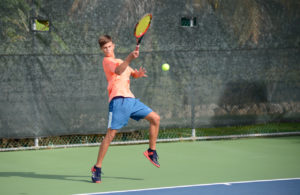- Tennis ace Oskar Bjuroe wins prestigious scholarship
- Intense play as corporate squash heads into final week
- A historic first for Latinos FC
- Elite, Scholars share women’s crowns
- Aaron Jarvis commits to UNLV, dreams of playing professionally
- Cayman’s World Cup qualifying opponents drawn
- BTFC back on top as CIFA Premier League Champions
- Certification offered for football referees
- Footballers to remember Gonzalo with ‘minute of silence’
- Corporate squash league serves up excitement
Landmark surgery for national rugby player
- Updated: 4 September 2018
 As he recovers, Westin focuses on teaching young children the game.
As he recovers, Westin focuses on teaching young children the game.
After years of repeated injury, Cayman Islands national rugby player Edward Weston’s shoulder had dislocated over 100 times. Even after corrective surgery, the joint was so damaged that it would dislocate in his sleep.
In the first surgery of its kind in the Americas, the Health City Cayman Islands orthopedic surgical team led by Dr. Alwin Almeida, Chief Orthopedic Surgeon and Joint Replacement Specialist, repaired Weston’s shoulder with a minimally invasive arthroscopic surgery utilising an advanced technique not yet available in the United States or Canada.
The surgery is called an arthroscopic Latarjet and is the minimally invasive adaptation of a commonly used surgical procedure in orthopedics and sports medicine.
“They do Latarjets in the U.S., but arthroscopic Latarjet is less common. The technique that we used was a special technique, which was [first] described by Dr. Pascal Boileau. This is probably the first time it has been done in the region,” Dr. Almeida explained.
The Latarjet operation, also known as the Latarjet-Bristow procedure, is a surgical procedure used to treat recurrent shoulder dislocations, typically caused by bone loss or a fracture of the glenoid. The procedure was first described by French surgeon Dr. Michel Latarjet in 1954.
The arthroscopic Latarjet is one of the most difficult surgeries in shoulder arthroscopy and only a few surgeons in the world have the training to perform this technique.
The Health City orthopedic surgical team used both surgical implants and techniques pioneered by the UK-based global medical device company Smith & Nephew, and which are used throughout Europe.
Dr. Alwin explained, “It hasn’t been done in the U.S. with that particular implant.” The ‘double button’ technique is not available in the U.S. yet, it’s only going to be launched there next year.
After examining Westin and reviewing his medical records, Dr. Almeida thought he was a good candidate for the surgery.
Westin had a condition called recurrent dislocation of the shoulder. He’d had surgery on his left shoulder previously, which failed. He was reluctant to try again, but then he met Dr. Almeida at a 2017 press conference where Health City Cayman Islands announced the hospital’s sponsorship of the Big Game, an annual rugby event in the Cayman Islands.
Westin described the process that led him to the pioneering procedure: “He [Dr. Almeida] actually goes to the same church as me, and so I explained about my injuries. I have dislocated my shoulders multiple times over the last few years, and he said whenever I have a break in my playing just to get a hold of him and come down to Health City and get them checked out and see what we can do.”
Dr. Alwin noted the severity of Westin’s condition: “It got to a point where it would dislocate even in his sleep, and he told me that it had dislocated probably more than 100 times – which is a lot.”
After going over his records, Dr. Alwin decided on the best procedure to help treat Mr. Westin’s condition.
“I studied the images and the surgery that was done on the left side and we realized he had undergone a surgery known as arthroscopic Bankart surgery. But the problem with him was really the bone loss. His glenoid socket was so small, and to add to that, the added bone loss that he had made it even smaller. So he had a very unstable shoulder. I had to decide to do what is known as an arthroscopic Latarjet procedure,” Dr. Almeida explained.
Dr. Alwin detailed how the surgery is performed: “In these type of procedures, what we do is we take the coracoid process with the attached tendons to it and we transfer this. We saw if off and we transfer this coracoid to the glenoid base, because this glenoid socket has lost bone in the front, and we put this coracoid bone at that point. That gives the stability and makes up for the bone loss, and it gives stability from the ligaments and the tendons attached to it.”
Westin was confident in the Health City team’s expertise going in to the surgery, and is pleased with the results.
“Dr. Alwin was pretty great and you can tell like the amount of knowledge that he has about the subject. He’s like showing me the videos of the surgery and explaining what they did in surgery and everything is really good,” he said.
After his surgery in March 2018, Westin is on the road to recovery and he hasn’t ruled out playing rugby again in the future.
“That’s the plan right now,” he said. “I still want to get back on the field, but I guess I have to assess after that year of recovery [and] make sure I’m ready for it, first of all.”
For now, Westin is coaching younger children in the Cayman Islands’ national rugby program.
After his experience at Health City Cayman Islands, he said he would definitely recommend the hospital to his rugby teammates.
“I’ve mentioned to it to a few people already. I know other rugby players that have already had procedures done there and with good results,” he said.





You must be logged in to post a comment Login